An “Out of this World” Interview with Curator Elyse Zorn Karlin
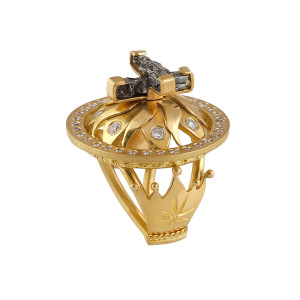
The Love that Moves the Sun & the Other Stars Ring , Donna Distefano, American & Italian, 22k gold, meteorite, diamond. Courtesy of the artist.
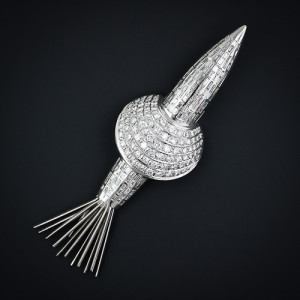
Rocket Ship Brooch, Unknown maker, American, mid-1960s, platinum, diamond. Lang Antiques, San Francisco.
A terrific exhibition opened at the Forbes Galleries in New York several weeks ago, titled “Out of this World: Jewelry in the Space Age“, it examines how space exploration has influenced the design of both fine and non-precious jewelry.
I recently sat down with Elyse Zorn Karlin, the exhibition’s curator, to chat about this fascinating topic.
- What is the earliest example of jewelry inspired by the space age that you have included in your exhibition?
Since the exhibition starts with the Late Georgian and Victorian eras, the earliest examples we have in our exhibition are circa 1835 Halley’s comet brooches which were very popular around the time the comet returned.
- What is the most interesting piece of jewelry that you found made from a material from space?
Although it’s one of the smallest pieces in the exhibition, the cross made from Palladot (pallasite) is amazing because this is peridot which is found in meteorites. It is rare and only found in very small pieces.
- Which period produced the most space age inspired jewelry and why?
I guess I would have to say the late 1950s and 1960s when we entered the space race with Russia. And it continued on right through the 80s and it seems to be alive and well today in more abstract visions of space seen in contemporary jewelry. Some of the artists in our exhibition work almost exclusively with materials from space or with space-related themes.
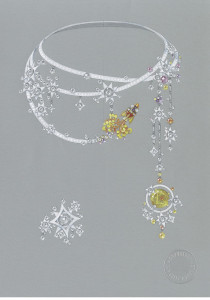
Tampa Necklace. Van Cleef & Arpels, French, 2010 . White and yellow gold with round, baguette and rose-cut diamond, round pink, purple and yellow sapphire, rose-cut blue sapphire, onyx, round orange garnet, round red spinel and round beryl. Private Collection.
- No doubt the star piece of the show is the “TAMPA” necklace by Van Cleef & Arpels. Can you tell us about the circumstances surrounding its inception? Who was it made for (I know its in a private collection but maybe there is something that you can reveal)?
The TAMPA necklace, created in 2010 by the renowned firm of Van Cleef & Arpels, is set in white and yellow gold with round, baguette and rose-cut diamonds, round pink, purple and yellow sapphires, rose-cut blue sapphires, an onyx motif, round orange garnets, round red spinels and a round beryl.
This necklace is part of the LES VOYAGES EXTRAORDINAIRESTM High Jewelry collection. The necklace was inspired by the Jules Verne novel From the Earth to the Moon first published in 1865. The book tells the story of the president of a Baltimore gun club and his rival, a Philadelphia maker of armor, and a Frenchman, who build an enormous sky-facing space gun and launch themselves in a spaceship from it to land on the moon.
It is now in a private collection but was not a commission. The pieces in the entire collection are absolutely amazing!
Besides the fact that this necklace is so beautiful, it also has detachable pendants so it can be configured many different ways. And it amazes me that Jules Verne was writing about rockets to the moon in the 19th century! I believe the name Tampa is because in the book they launched from Tampa, Florida which also presages Cape Canaveral!!!
- Can you tell us about the jewelry made from materials that are used in spacecraft?
Perhaps that two most popular materials that have been used to make jewelry that were used in spacecrafts are Polymer and Titanium. Polymers are a large class of materials based on carbon chemistry. They possess long chain structures and unique molecular architecture that make them different from metals and ceramics, and give them a wide range of properties. Polymers can be modified by adding other filler materials to provide an endless range of possible usages. Polymeric materials are widely used for many spacecraft components including adhesives, circuit boards, temperature regulating “blankets,” lubricants, electrical insulation, paints, and high stiffness composites.
Polymer clay is a sculpting medium used by artists. It is soft and can be easily shaped into highly inventive forms, take image transfers, and be mixed with other materials. It is then heat hardened. Polymer jewelry has in recent years been recognized as an important oeuvre.
Titanium. Titanium is a chemical element with two very special properties: it resists corrosion and it has the highest strength-to-weight ratio of any metal. When mixed with other elements it forms a strong lightweight alloy that resists cracks and fatigue and retains its strength at high temperatures. It therefore is used in jet engines, missiles, spacecraft, and other aerospace applications. Titanium is found in meteorites and has been detected in certain types of stars, including our Sun.
Jewelers like titanium for its durability and because of its reactive properties. By reacting to electrical current or heat it develops an oxide layer that appears brightly colored. But the colors are an illusion, formed by interference between light reflected from the oxide surface layer and light reflected from the metal surface beneath. Titanium is also non-allergenic which is desirable for jewelry.
Out of this World: Jewelry in the Space Age, March 16 – September 7, 2013, at the Jewelry Gallery, The Forbes Galleries, 62 Fifth Avenue, at the corner of Fifth Avenue and 12th Street, in New York City.
Calendar
| M | T | W | T | F | S | S |
|---|---|---|---|---|---|---|
| 1 | 2 | 3 | 4 | 5 | 6 | 7 |
| 8 | 9 | 10 | 11 | 12 | 13 | 14 |
| 15 | 16 | 17 | 18 | 19 | 20 | 21 |
| 22 | 23 | 24 | 25 | 26 | 27 | 28 |
| 29 | 30 | 31 | ||||
Archives
- June 2018
- March 2018
- December 2016
- January 2016
- November 2015
- September 2015
- August 2015
- June 2015
- March 2015
- February 2015
- December 2014
- November 2014
- October 2014
- May 2014
- April 2014
- January 2014
- December 2013
- November 2013
- October 2013
- September 2013
- June 2013
- May 2013
- April 2013
- March 2013
- February 2013
- December 2012
- November 2012
- October 2012
- September 2012
- August 2012
- July 2012
- June 2012
- May 2012
- April 2012
- March 2012
- February 2012
- January 2012
- December 2011
- November 2011
- October 2011
- September 2011
- July 2011
- June 2011
- May 2011
- April 2011
- March 2011
- February 2011
- January 2011
- December 2010
- November 2010
- October 2010
- September 2010
- July 2010
- June 2010
- May 2010
- April 2010
- March 2010
- February 2010
- January 2010
- December 2009
- November 2009
- October 2009
- September 2009
- August 2009
- July 2009
- June 2009
Categories
- 20th c. design
- Architecture
- Art Deco
- Art Jewelry Forum
- Art Nouveau
- Auction
- Bard Graduate Center
- Blog update
- Brooklyn Metal Works
- Brooklyn Museum
- Ceramics
- Christie's
- Contemporary Art
- Contemporary Design
- Cooper-Hewitt
- Costume Institute
- Decorative Arts Calendar
- Design Exhibition Review
- Designer Spotlight
- Exhibition review
- Extraordinary lives
- Fashion
- Fashion exhibition review
- Fashion photography
- Film
- Fresh Talent
- Furniture
- Gallery Spotlight
- Glass
- ICP NY
- Italian Design
- Jewelry
- Lecture
- MCNY
- Metropolitan Museum of Art
- MoMA
- Museum at F.I.T
- Museum of Arts and Design
- Neue Galerie NY
- On the Market
- Paper Art
- Paris
- Phillips de Pury & Company
- Pinakothek de Moderne
- Platforma
- Public Art
- Rago
- Recently Published Articles
- Russian Decorative Arts
- R|R Gallery
- Sculpture
- Sotheby's
- Television
- Textiles
- Travel
- Uncategorized
- Upcoming Events
- Vintage Clothing
- Wiener Werkstatte
- Wright
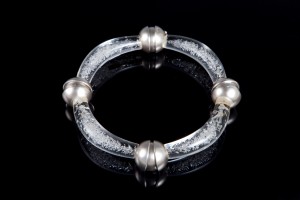
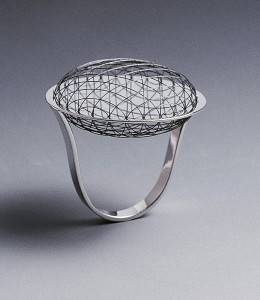
Leave a Reply